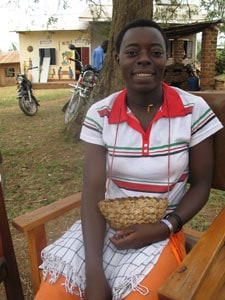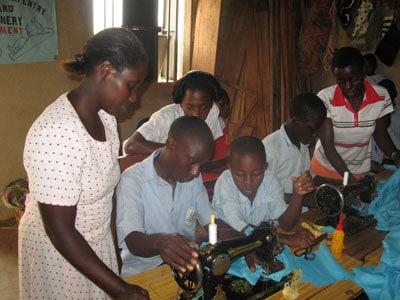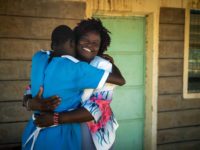Formal education was not the path to fulfilling the dreams of 19-year-old Fausta. No matter how hard she tried, she never got good grades. While all the children around her seemed to grasp and enjoy the class work, Fausta had trouble comprehending the lessons, let alone enjoying them.
With the support of our staff, Fausta pushed on and tried her best to excel. However, when her Primary Leaving Examinations* results came back, she had failed. It was then that Fausta made a decision to discontinue formal education despite Compassion’s willingness to pay her school fees. She decided instead to train in tailoring.
At Nakatete Child Development Center, the center Fausta attends, children 12 years of age and older can choose vocational training in any area they want and the trainers will gladly take them through it. The program is optional and those who are not interested don’t join.
The center has classes for skills like weaving, crocheting and tailoring. The children make mats, micro hangers for flowers, tablecloths, handbags, door mats, dresses, skirts, shorts, shirts and blouses every alternating Saturday.
Out of 71 children in primary school who are of age, 53 have joined the vocational classes. The tailoring class has 10 boys and three girls, weaving has nine girls, knitting has 18 girls, making door mats has 10 boys, and broom making has seven boys and three girls.
Six of these children have also chosen to study more than one vocation. The vocational training, however, is not very popular with the children in secondary school.
“When they reach secondary school, the children refuse to continue with the trainings, saying it is for the illiterate. We have tried to sensitize them about the importance of the vocational trainings, but some of them do not take heed. So far we have 110 children in secondary school, but only 20 of these are in vocational training.” — Mrs. Olivia, the center director
 While many show disinterest in the vocational classes, some are progressing and enjoying the benefits already. Fausta has now mastered the art of knitting tablecloths, tailoring and weaving mats, and has already sold some of her products.
While many show disinterest in the vocational classes, some are progressing and enjoying the benefits already. Fausta has now mastered the art of knitting tablecloths, tailoring and weaving mats, and has already sold some of her products.
“I joined the vocations class at the age of 12 and by the time I was 15 years old, I was able to make some products and sell them to sustain myself. The first profit I got was from selling three sets of tablecloths. When I got this money I used it to buy three chickens and started a chicken-rearing business. I used the rest of the money to buy clothes and shoes.”
One of Fausta’s chickens now has six chicks, and it represents just the beginning of her success in business. She joined a friend’s tailoring business to learn new designs of tailoring clothes and to upgrade from the basic tailoring of dresses, shirts, blouses and shorts that is taught at the center. Today, she has advanced to making gomesis, a traditional dress of the Baganda tribe and other tribes in central and eastern Uganda.
With this exposure, she has improved her skills to meet the standards of her customers. On average she gets $.90 per item of clothing that she sews at her friend’s business. Once in a while, though, she gets her own deals to make clothes and the profits are higher. The price depends on the design and type of fabric that is used.
So far she has made and sold seven gomesis. She sold them at different prices, an average of $2.65.
Fausta and her family also do not have to buy tablecloths and chair backs for their sitting room because Fausta has made them herself.
Fausta might not have pursued formal education, but she knows how to survive with what she has been equipped. Her dream is to start her own business and be able to get contracts to make school uniforms and start up a store selling gomesis.
She embodies dreams fulfilled for the staff members who take the time and effort to equip these children.
“We encourage all the children to join vocational trainings so that they can be economically self sustaining. For example, we expect that when children reach secondary school, they should be able to raise money to top up their school fees or get pocket money by selling the products they have learned to make.
“We also expect them to apply this knowledge in their homes. For example, why should parents spend money buying tablecloths when the children can make them?
“Some of them have indeed made us proud. One of the children who had mastered the skill of carpentry got a contract to make benches for this school. It was fulfilling to see that we didn’t have to outsource but could support our own.” — Olivia
The vocational classes begin at 2 p.m. after the children have had their lunch. Those that do tailoring rush to their small, busy room for lessons. The rest of the children who take crocheting and weaving find shade under a big tree. There they sit in different groupings depending on the work they are doing; knitting tablecloths, making mats, making brooms and making door mats.
Under the tree, they enjoy the cool breeze that sweeps over them. They giggle and practice what they were last taught until their instructor arrives. Their instructor, Betty, moves from child to child, keenly observing what each child does and correcting or complimenting his/her work.

One by one, they receive attention and get to ask all the questions they have about their work. From an observer’s point of view, the children are drawn into their work and they love it!
The children in the tailoring class share the sewing machines and learn together. Betty moves from one machine to another, giving them details of the foundational knowledge they need to make good products. She labors to explain to some of them who are still finding difficulty grasping the basics. Others need less supervision.

Twelve-year-old Jonathan is to finish making his first dress today. He is “over the moon” as he has been working on the dress since last year. His face beams with happiness as he shows off his dress. He is very alert when receiving guidance from his instructor.
Thirteen-year-old Henry is learning how to make brooms and door mats. He hopes to make some money out of this vocation so that he can support his one parent. The children learn with passion and hope. They know that one day this will pay.
At the child development center, the caregivers have a say in what vocations their children can take. Olivia says that before the center decides on what vocations to teach the children, the staff consult the parents.
“When selecting which vocations to teach, we do a needs assessment with the caregivers. We ask them to suggest vocations that are relevant for their children. We also consider a vocation that is relevant to community needs. We need to teach the children products that can be economically benefiting to them. Availability of human resource is another factor we consider. For example we wanted to have a bakery here but have not yet found a trainer.”
The future of the children is unknown. But the child development center is providing the opportunity and environment for the children to learn. The hope is that we have made a difference in the life of another child.
*Primary Leaving Examinations also serve as entrance exams into secondary (or high) school. Failure to pass these exams usually means a child cannot progress to secondary school, particularly at a good school. When a student has done poorly in exams, it is possible to take another year of the same class and sit for the examinations again.







11 Comments |Add a comment
Thankyou for sharing this story. My future endeavour is to teach sewing and hospitality in Uganda. This has given me some insight into some problems and victories of vocational education. God bless
Is there a way to stay in touch with your sponsored child after that child has graduated from the program? I have developed such an attachment and don’t know what I’ll do when they graduate and I never hear from them again!
It is great what Compassion is doing to make their lives better. May God reward all your endevours. Thank you Carole for this article. It was a nice read.
LOVED this! Thank you SO much for sharing it in such detail with us! I try to advocate for the older children and so this was so helpful to be able to share with prospective sponsors of teenagers about the ways our kids are being prepared to be self-reliant. I hope to hear even more about how the children are being equipped and trained.
I very much appreciated this post. One of my girls in Uganda is taking the Tailoring and Cutting course. After reading the article I wrote her and told her again how wonderful this course is for her and reminded her of the story of Dorcas in Acts 9:36-43, ( and how she was loved because she had the skill to create garments:
Dorcas Restored to Life
36 At Joppa there was a certain disciple named Tabitha, which is translated Dorcas. This woman was full of good works and charitable deeds which she did. 37 But it happened in those days that she became sick and died. When they had washed her, they laid her in an upper room. 38 And since Lydda was near Joppa, and the disciples had heard that Peter was there, they sent two men to him, imploring him not to delay in coming to them. 39 Then Peter arose and went with them. When he had come, they brought him to the upper room. And all the widows stood by him weeping, showing the tunics and garments which Dorcas had made while she was with them. 40 But Peter put them all out, and knelt down and prayed. And turning to the body he said, “Tabitha, arise.” And she opened her eyes, and when she saw Peter she sat up. 41 Then he gave her his hand and lifted her up; and when he had called the saints and widows, he presented her alive. 42 And it became known throughout all Joppa, and many believed on the Lord. 43 So it was that he stayed many days in Joppa with Simon, a tanner. NKJV
Lauren
Good story! I like hearing about the older kids and I like it that Compassion is looking for very practical ways to prepare them for independence.
Hello Fausta, thank you for allowing your story to be shared with us all around the world! It is obvious to me that you are an intelligent young lady- look at the wonderful things that you have made and the wonderful ideas that you have! Intelligence comes in many different forms- God has obviously gifted you with intelligence in making and creating things. I am so impressed by you. It is wonderful to see you in the photo helping the younger students with their sewing- I am sure you are a great help at your Project Centre. Congratulations on your business success. I wish you all the very best for the future, and I hope that your dreams come true. Blessings in Jesus.
Thanks for the post, my kiddo in India struggles with school work, I hope my sponsorship helps relieve some of the stress so that she can focus on her studies. She is learning computers. Knowing that there is hope for this precious little one helps. Thanks again for the post.
What an interesting subject. However, I wonder if some of these kids have learning disorders (dyslexia, etc.) that, if addressed, might make them more college ready?
When we visited one of our sponsor children in Ethiopia, Sintayehu was taking vocational classes. She told us, “Accountants and secretaries can have university but find no work. *I* will always have work!” (speaking of the skills she learned in her vocational classes).
I certainly hope that is true, as she has since ‘aged out’ of the program.
Teri
teri-gonewalkabout2.blogspot.com
Thank you for the reminder! Most definitely will be praying for the vocational programs all over. God bless these students and your teachers!